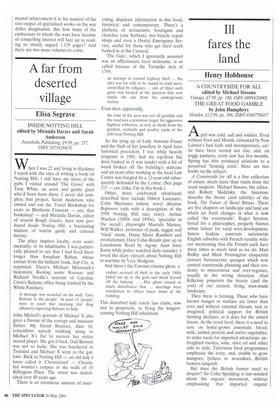A far from deserted village
Elisa Segrave
INSIDE NOTTING HILL edited by Miranda Davies and Sarah Anderson Portobello Publishing, £9.99, pp. 257, ISBN 187342941X When I was 22 and living in Hackney I toyed with the idea of writing a book on Notting Hill. I still have my notes of the pubs I visited around 'The Grove' with Tony White, an actor and gentle giant who'd been born there. I never did complete that project. Sarah Anderson, who owned and ran the Travel Bookshop for years in Blenheim Crescent — yes, that bookshop! — and Miranda Davies, editor of several Rough Guides, have now produced Inside Notting Hill, a fascinating mixture of tourist guide and cultural history.
The place inspires loyalty, even sentimentality, in its inhabitants. I was pathetically pleased to see that I had lived there longer than Jonathan Raban, whose extract from his brilliant book, Soft City, is reprinted. There's Michael Moorcock's hedonistic Rocking under Westway and Richard Neville's account of Caroline Coon's Release office being trashed by the White Panthers:
A message was scrawled on the wall, 'Give Release to the people'. At least 15 'people' were in court that morning (for drug offences) expecting Release to help.
John Michell's portrait of Michael X also gives a flavour of the corrupt and innocent Sixties. My friend Beatrice, then 18, remembers naively trekking along to Michael X's flat to recover her stolen record player. She got it back. Gail Benson was not so lucky. She was butchered in Trinidad and Michael X went to the gallows. Back in Notting Hill — an old lady I knew called it 'Christieland' — Christie hid women's corpses in the walls of 10 Rillington Place. The street was demolished over 40 years ago.
There is an enormous amount of inter
esting, disparate information in this book, historical and contemporary. There's a plethora of restaurants, boutiques and churches (one Serbian), two bicycle repair shops and even a Dental Emergency Service, useful for those who get their teeth bashed in at the Carnival.
'The Gate', which I ignorantly assumed was an affectionate local nickname, is so called because of the Turnpike Acts of 1769,
an attempt to control highway theft ... the idea was for tolls to be issued to road users, controlled by tollgates ... one of three such gates was located at the junction that now marks the exit from the underground station.
Even then, apparently,
the tone of the area was not all gentility and the road was a notorious target for aggressive highway robberies, as well as thefts from the gardens, orchards and poultry yards of the still-rural Notting Hill.
So the tying up of Lady Antonia Fraser and the theft of her jewellery in April have historical precedent. I too, while heavily pregnant in 1981, had my top-floor flat door bashed in (I was inside) with a bit of wood broken off the building's staircase and six years after working at the local Law Centre was burgled by a 12-year-old subsequently defended by the Centre. (See page 215 yes, folks, I'm in this book.)
Other, more celebrated inhabitants described here include Osbert Lancaster, Colin MacInnes (whose novel Absolute Beginners ends with a description of the 1958 Notting Hill race riots), Arthur Machen (1880s and I890s), 'specialist in the occult', playwright Mustafa Matura, Will Walker, promoter of punk, reggae and 'black' music, Dame Marie Rambert and revolutionary Dani Cohn-Bendit (put up in Lansdowne Road by Agony Aunt Irma Kurtz while police watched daily outside). I loved the diary extracts about Notting Hill in wartime by Vere Hodgson.
And there's the Coronet cinema ghost, a
cashier accused of theft in the early 1900s [who] ran up to the gods and threw herself off the balcony . . Her ghost caused so much disturbance that ... meetings were transferred to offices lower down in the building.
This disturbed lady surely lays claim, now and in perpetuity, to being the longestrunning Notting Hill inhabitant.


















































































 Previous page
Previous page